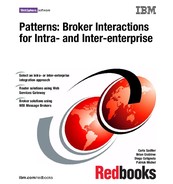26 Broker Interactions for Intra- and Inter-enterprise
This classification framework is used later in this chapter to classify Application
patterns for both Application Integration patterns (intra-enterprise) and Extended
Enterprise business patterns (inter-enterprise).
2.3 QoS capabilities framework
This section documents the most frequently observed Quality of Service (QoS)
concerns that must be considered in implementing integration solutions. These
QoS manifest themselves with differing degrees of importance and specificity in
different integration scenarios.
The following QoS concerns are defined in this section:
? Operability
? Availability
? Federation
? Performance
? Security
? Standards compliance
? Transactionality
2.3.1 Operability
This QoS concern focuses on the systems management requirements of the
deployed solution. It focuses on issues such as monitoring, logging, traces,
recovery, and manageability of the solution during operations in a production
environment.
2.3.2 Availability
Availability is a measure of the time that a service is functioning normally as well
as a measure of the time the recovery process requires after the service fails. In
other words, it is the downtime that defines service availability. This downtime
includes both planned and unplanned downtime.
High availability generally requires that a topology provide some degree of
redundancy in order to eliminate single points of failure. This allows the
downtime caused by a component failure to be minimized (ideally zero). It can
also allow a service to continue functioning normally during the downtime of a
component for planned maintenance or backup procedures, for example.
Chapter 2. Fundamental concepts in Process Integration 27
2.3.3 Federation
Federation is fundamentally about enabling services to interoperate across trust
boundaries. It lets access control functions span across multiple domains,
crossing application, product, platform, site, business unit, and organization
boundaries.
Federation requires that each partner domain is trusted to authenticate the
identity of its own users. Mechanisms are needed for passing resource and user
authentication and authorization information between domains.
2.3.4 Performance
The performance of a service is measured in terms of throughput and latency.
Throughput represents the number of requests served in a given time period.
Latency is the round-trip time between sending a request and receiving the
response. Higher throughput and lower latency values represent good
performance of a service.
Scalable topologies are able to service higher loads by adding the appropriate
processing power. This be achieved using techniques such a using a faster
machine, using a special purpose machine, or creating a cluster of machines.
Other performance improvement techniques include caching, batching and
connection pooling.
2.3.5 Security
Permission to access the participating applications may be associated with the
requesting application itself, or this application may carry the credentials of a
user initiating the actions. Consequently, access control can be applied as far as
the requesting application (a transit of trust) or only from an integration hub (a
trusted source) that authenticated the original request.
Securing messages transported and ensuring that integration is achieved only
with authorized applications under the correct user credentials is a must. The
integration solution needs to provide:
? Data protection through encryption
? Authentication of users and subscribing applications. In cases where
non-repudiation of the end-user is required, authentication of the end-user
? Authorization of the user for participation in an integration activity
..................Content has been hidden....................
You can't read the all page of ebook, please click here login for view all page.
